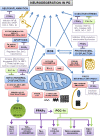PPARγ and PGC-1α as therapeutic targets in Parkinson's
- PMID: 25007880
- PMCID: PMC4326663
- DOI: 10.1007/s11064-014-1377-0
PPARγ and PGC-1α as therapeutic targets in Parkinson's
Abstract
The peroxisome proliferator-activated receptor gamma (PPARγ) is a ligand-activated transcriptional factor that belongs to the nuclear hormone receptor superfamily. PPARγ was initially identified through its role in the regulation of glucose and lipid metabolism and cell differentiation. It also influences the expression or activity of a number of genes in a variety of signalling networks. These include regulation of redox balance, fatty acid oxidation, immune responses and mitochondrial function. Recent studies suggest that the PPARγ agonists may serve as good candidates for the treatment of several neurodegenerative disorders including Parkinson's disease (PD), Alzheimer's disease, Huntington's disease and amyotrophic lateral sclerosis, even though multiple etiological factors contribute to the development of these disorders. Recent reports have also signposted a role for PPARγ coactivator-1α (PGC-1α) in several neurodegenerative disorders including PD. In this review, we explore the current knowledge of mechanisms underlying the beneficial effects of PPARγ agonists and PGC-1α in models of PD.
Figures

References
-
- Desvergne B, Wahli W. Peroxisome proliferator-activated receptors: nuclear control of metabolism. Endocr Rev. 1999;20(5):649–688. - PubMed
-
- Michalik L, Auwerx J, Berger JP, Chatterjee VK, Glass CK, Gonzalez FJ, Grimaldi PA, Kadowaki T, Lazar MA, O’Rahilly S, Palmer CN, Plutzky J, Reddy JK, Spiegelman BM, Staels B, Wahli W. International union of pharmacology. LXI. Peroxisome proliferator-activated receptors. Pharmacol Rev. 2006;58(4):726–741. doi: 10.1124/pr.58.4.5. - DOI - PubMed
Publication types
MeSH terms
Substances
Grants and funding
LinkOut - more resources
Full Text Sources
Other Literature Sources
Medical

